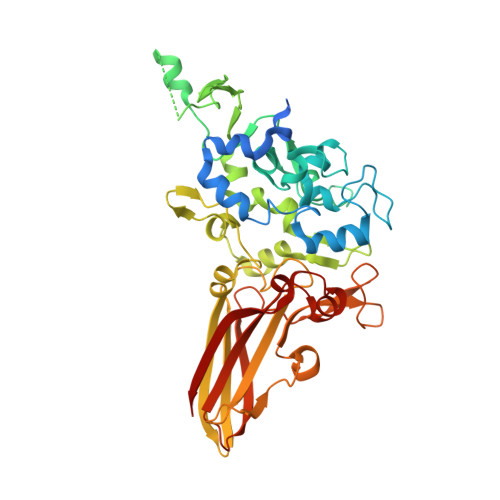Properties and structure of a low-potential, penta-heme cytochrome c552from a thermophilic purple sulfur photosynthetic bacterium Thermochromatium tepidum.
Chen, J.H., Yu, L.J., Boussac, A., Wang-Otomo, Z.Y., Kuang, T., Shen, J.R.(2019) Photosynth Res 139: 281-293
- PubMed: 29691716
- DOI: https://doi.org/10.1007/s11120-018-0507-y
- Primary Citation of Related Structures:
5ZE8 - PubMed Abstract:
The thermophilic purple sulfur bacterium Thermochromatium tepidum possesses four main water-soluble redox proteins involved in the electron transfer behavior. Crystal structures have been reported for three of them: a high potential iron-sulfur protein, cytochrome c', and one of two low-potential cytochrome c 552 (which is a flavocytochrome c) have been determined. In this study, we purified another low-potential cytochrome c 552 (LPC), determined its N-terminal amino acid sequence and the whole gene sequence, characterized it with absorption and electron paramagnetic spectroscopy, and solved its high-resolution crystal structure. This novel cytochrome was found to contain five c-type hemes. The overall fold of LPC consists of two distinct domains, one is the five heme-containing domain and the other one is an Ig-like domain. This provides a representative example for the structures of multiheme cytochromes containing an odd number of hemes, although the structures of multiheme cytochromes with an even number of hemes are frequently seen in the PDB database. Comparison of the sequence and structure of LPC with other proteins in the databases revealed several characteristic features which may be important for its functioning. Based on the results obtained, we discuss the possible intracellular function of this LPC in Tch. tepidum.
Organizational Affiliation:
Photosynthesis Research Center, Key Laboratory of Photobiology, Institute of Botany, Chinese Academy of Sciences, No. 20, Nanxincun, Xiangshan, Beijing, 100093, China.

















